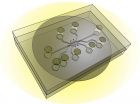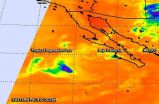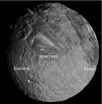(Press-News.org) WEST LAFAYETTE, Ind. – Researchers have developed a chip capable of simulating a tumor's "microenvironment" and plan to use the new system to test the effectiveness of nanoparticles and drugs that target cancer.
The new system, called a tumor-microenvironment-on-chip (T-MOC) device, will allow researchers to study the complex environment surrounding tumors and the barriers that prevent the targeted delivery of therapeutic agents, said Bumsoo Han, a Purdue University associate professor of mechanical engineering.
Researchers are trying to perfect "targeted delivery" methods using various agents, including an assortment of tiny nanometer-size structures, to selectively attack tumor tissue.
One approach is to design nanoparticles small enough to pass through pores in blood vessels surrounding tumors but too large to pass though the pores of vessels in healthy tissue. The endothelial cells that make up healthy blood vessels are well organized and have small pores in the tight junctions between them. However, the endothelial cells in blood vessels around tumors are irregular and misshapen, with larger pores in the gaps between the cells.
"It was thought that if nanoparticles were designed to be the right size they could selectively move toward only the tumor," Han said.
However, one complication hindering the success of this strategy is that the pressure of "interstitial fluid" inside tumors is greater than that of surrounding healthy tissue. This greater pressure pushes out most drug-delivery and imaging agents, with only a small percentage of them reaching the target tumor.
Now, new research findings suggest that the T-MOC system is capable of simulating the complex environment around tumors and providing detailed information about how nanoparticles move through this environment. Such information could aid efforts to perfect targeted delivery methods.
The findings are detailed in a research paper appearing online this month and will be published in a print edition of the Journal of Controlled Release in November. The paper was authored by postdoctoral research associate Bongseop Kwak; graduate students Altug Ozcelikkale and Crystal S. Shin; Kinam Park, the Showalter Distinguished Professor of Biomedical Engineering and a professor of pharmaceutics; and Han.
The T-MOC chip is about 4.5 centimeters (1.8 inches) square and contains "microfluidic" channels where tumor cells and endothelial cells are cultured. The chip also incorporates extracellular matrix – a spongy, scaffold-like material made of collagen found between cells in living tissue.
The new chip offers an alternative to conventional experimental methods. Studies using cancer cells in petri plates exclude the complex microenvironment surrounding tumors, and research with animals does not show precisely how proposed therapies might work in people.
However, the T-MOC system has the potential to mimic cancer in humans, Han said.
The researchers tested the technology using human breast cancer and endothelial cells and studied how nanoparticles moved within the microenvironment.
Future work will expand to the study of anticancer drugs. Eventually, the devices might be used to grow tumor cells from patients to gauge the effectiveness of specific drugs in those people.
INFORMATION:
The work is based at the Birck Nanotechnology Center in Purdue's Discovery Park. It was supported by the National Science Foundation, National Institutes of Health, and a Collaboration in Translational Research Award from the Indiana Clinical and Translational Sciences Institute. Han's work also been supported by the B.S.F. Schaefer Award, the Discovery Park Fellowship, and an Incentive Grant Program from Purdue.
Writer: Emil Venere, 765-494-4709, venere@purdue.edu
Source: Bumsoo Han, 765-494-5626, bumsoo@purdue.edu,
Related websites:
Bumsoo Han: https://engineering.purdue.edu/BPL
IMAGE CAPTION:
This illustration shows the design of a new chip capable of simulating a tumor's "microenvironment" to test the effectiveness of nanoparticles and drugs that target cancer. The new system, called a tumor-microenvironment-on-chip device, will allow researchers to study the complex environment surrounding tumors and the barriers that prevent the targeted delivery of therapeutic agents. (Purdue University photo/Altug Ozcelikkale, Bumsoo Han)
A publication-quality image is available at https://news.uns.purdue.edu/images/2014/han-chip.jpg
ABSTRACT
Simulation of Complex Transport of Nanoparticles around a Tumor Using Tumor- Microenvironment-on-Chip
Bongseop Kwak, Altug Ozcelikkale, Crystal S Shin, Kinam Park, and Bumsoo Han
Purdue University
Delivery of therapeutic agents selectively to tumor tissue, which is referred as "targeted delivery," is one of the most ardently pursued goals of cancer therapy. Recent advances in nanotechnology enable numerous types of nanoparticles (NPs) whose properties can be designed for targeted delivery to tumors. In spite of promising early results, the delivery and therapeutic efficacy of the majority of NPs are still quite limited. This is mainly attributed to the limitation of currently available tumor models to test these NPs and systematically study the effects of complex transport and pathophysiological barriers around the tumors. In this study, thus, we developed a new in vitro tumor model to recapitulate the tumor microenvironment determining the transport around tumors. This model, named tumor-microenvironment-on-chip (T-MOC), consists of 3-dimensional microfluidic channels where tumor cells and endothelial cells are cultured within extracellular matrix under perfusion of interstitial fluid. Using this T-MOC platform, the transport of NPs and its variation due to tumor microenvironmental parameters have been studied including cut-off pore size, interstitial fluid pressure, and tumor tissue microstructure. The results suggest that T-MOC is capable of simulating the complex transport around the tumor, and providing detailed information about NP transport behavior. This finding confirms that NPs should be designed considering their dynamic interactions with tumor microenvironment.
New chip promising for tumor-targeting research
2014-09-22
ELSE PRESS RELEASES FROM THIS DATE:
Brainwave test could improve autism diagnosis and classification
2014-09-22
September 22, 2014 – (BRONX, NY) – A new study by researchers at Albert Einstein College of Medicine of Yeshiva University suggests that measuring how fast the brain responds to sights and sounds could help in objectively classifying people on the autism spectrum and may help diagnose the condition earlier. The paper was published today in the online edition of the Journal of Autism and Developmental Disabilities.
The U.S. Centers for Disease Control and Prevention estimates that 1 in 68 children has been identified with an autism spectrum disorder (ASD). The signs and ...
Common diabetes drug associated with risk of low levels of thyroid hormone
2014-09-22
Metformin, a commonly used drug for treating type 2 diabetes, is linked to an increased risk of low thyroid-stimulating hormone (TSH) levels in patients with underactive thyroids (hypothyroidism), according to a study in CMAJ (Canadian Medical Association Journal). Low levels of TSH can cause harm, such as cardiovascular conditions and fractures.
Metformin is used to lower blood glucose levels by reducing glucose production in the liver. However, some previous studies have raised concerns that metformin may lower thyroid-stimulating hormone levels.
Researchers looked ...
University of Chicago neuroscientists challenge long-held understanding of the sense of touch
2014-09-22
Different types of nerves and skin receptors work in concert to produce sensations of touch, University of Chicago neuroscientists argue in a review article published Sept. 22, 2014, in the journal Trends in Neurosciences. Their assertion challenges a long-held principle in the field—that separate groups of nerves and receptors are responsible for distinct components of touch, like texture or shape. They hope to change the way somatosensory neuroscience is taught and how the science of touch is studied.
Sliman Bensmaia, PhD, assistant professor of organismal biology and ...
Variability keeps the body in balance
2014-09-22
Although the heart beats out a very familiar "lub-dub" pattern that speeds up or slows down as our activity increases or decreases, the pattern itself isn't as regular as you might think. In fact, the amount of time between heartbeats can vary even at a "constant" heart rate—and that variability, doctors have found, is a good thing.
Reduced heart rate variability (HRV) has been found to be predictive of a number of illnesses, such as congestive heart failure and inflammation. For athletes, a drop in HRV has also been linked to fatigue and overtraining. However, the underlying ...
NASA sees Tropical Depression Polo winding down
2014-09-22
Infrared satellite imagery from NASA's Aqua satellite showed only a swirl of low-level clouds some deep clouds around Polo's weakening center on Sept. 22 as the storm weakened to a depression.
The Atmospheric Infrared Sounder or AIRS instrument aboard Aqua gathered infrared data on Polo on Sept. 22 at 5:11 a.m. EDT, reading cloud top temperatures. There was a small area of high clouds, indicating that most thunderstorms in the depression had weakened or already dissipated except for that area.
At 5 a.m. EDT on Monday, Sept. 22, Tropical Depression Polo's maximum sustained ...
Compound from hops aids cognitive function in young animals
2014-09-22
CORVALLIS, Ore. – Xanthohumol, a type of flavonoid found in hops and beer, has been shown in a new study to improve cognitive function in young mice, but not in older animals.
The research was just published in Behavioral Brain Research by scientists from the Linus Pauling Institute and College of Veterinary Medicine at Oregon State University. It's another step toward understanding, and ultimately reducing the degradation of memory that happens with age in many mammalian species, including humans.
Flavonoids are compounds found in plants that often give them their ...
Engineers show light can play seesaw at the nanoscale
2014-09-22
University of Minnesota electrical engineering researchers have developed a unique nanoscale device that for the first time demonstrates mechanical transportation of light. The discovery could have major implications for creating faster and more efficient optical devices for computation and communication.
The research paper by University of Minnesota electrical and computer engineering assistant professor Mo Li and his graduate student Huan Li has been published online and will appear in the October issue of Nature Nanotechnology.
Researchers developed a novel nanoscale ...
Graphene imperfections key to creating hypersensitive 'electronic nose'
2014-09-22
Researchers have discovered a way to create a highly sensitive chemical sensor based on the crystalline flaws in graphene sheets. The imperfections have unique electronic properties that the researchers were able to exploit to increase sensitivity to absorbed gas molecules by 300 times.
The study is available online in advance of print in Nature Communications.
Amin Salehi- Khojin, asst professor of mechanical and industrial engineering in the lab with Mohammad Asadi, graduate student and Bijandra Kumar, post doc where they are doing research in graphene sensors. Photo: ...
Gravitational waves according to Planck
2014-09-22
No one has ever directly observed gravitational waves, phenomena predicted by Einstein's theory of General Relativity, and such a discovery would have profound implications for the study of the Universe. Last March, however, the team behind the BICEP2 project made a ground-breaking announcement: the Antarctic observatory had detected a signal referable to gravitational waves. The study claimed to have excluded possible contaminants (other sources that could have generated the same signal) and that the observation was therefore to be considered genuine. But not everyone ...
Miranda: An icy moon deformed by convection
2014-09-22
Boulder, Colo., USA – Miranda, a small, icy moon of Uranus, is one of the most visually striking and enigmatic bodies in the solar system. Despite its relatively small size, Miranda appears to have experienced an episode of intense resurfacing that resulted in the formation of at least three remarkable and unique surface features -- polygonal-shaped regions called coronae.
These coronae are visible in Miranda's southern hemisphere, and each one is at least 200 km across. Arden corona, the largest, has ridges and troughs with up to 2 km of relief. Elsinore corona has ...




